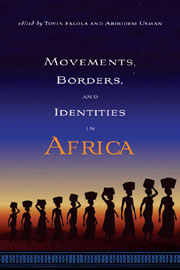Book contents
- Frontmatter
- contents
- Preface
- Introduction: Migrations in African History: An Introduction
- PART A State Formation and Migration Crossroads
- PART B Movements and Identities
- 6 Squatting and Settlement Making in Mamelodi, South Africa
- 7 “Scattering Time”: Anticolonial Resistance and Migration among the Jo-Ugenya of Kenya toward the End of the Nineteenth Century
- 8 Traders, Slaves, and Soldiers: The Hausa Diaspora in Ghana (Gold Coast and Asante) in the Nineteenth and Early Twentieth Centuries
- 9 Ethnic Identities and the Culture of Modernity in a Frontier Region: The Gokwe District of Northwestern Zimbabwe, 1963–79
- 10 Displacement, Migration, and the Curse of Borders in Francophone West Africa
- 11 Shifting Identities among Nigerian Yoruba in Dahomey and the Republic of Benin (1940s–2004)
- 12 Identity, “Foreign-ness,” and the Dilemma of Immigrants at the Coast of Kenya: Interrogating the Myth of “Black Arabs” among Kenyan Africans
- 13 Labor Market Constraints and Competition in Colonial Africa: Migrant Workers, Population, and Agricultural Production in Upper Volta, 1920–32
- List of Contributors
- Index
9 - Ethnic Identities and the Culture of Modernity in a Frontier Region: The Gokwe District of Northwestern Zimbabwe, 1963–79
from PART B - Movements and Identities
Published online by Cambridge University Press: 12 September 2012
- Frontmatter
- contents
- Preface
- Introduction: Migrations in African History: An Introduction
- PART A State Formation and Migration Crossroads
- PART B Movements and Identities
- 6 Squatting and Settlement Making in Mamelodi, South Africa
- 7 “Scattering Time”: Anticolonial Resistance and Migration among the Jo-Ugenya of Kenya toward the End of the Nineteenth Century
- 8 Traders, Slaves, and Soldiers: The Hausa Diaspora in Ghana (Gold Coast and Asante) in the Nineteenth and Early Twentieth Centuries
- 9 Ethnic Identities and the Culture of Modernity in a Frontier Region: The Gokwe District of Northwestern Zimbabwe, 1963–79
- 10 Displacement, Migration, and the Curse of Borders in Francophone West Africa
- 11 Shifting Identities among Nigerian Yoruba in Dahomey and the Republic of Benin (1940s–2004)
- 12 Identity, “Foreign-ness,” and the Dilemma of Immigrants at the Coast of Kenya: Interrogating the Myth of “Black Arabs” among Kenyan Africans
- 13 Labor Market Constraints and Competition in Colonial Africa: Migrant Workers, Population, and Agricultural Production in Upper Volta, 1920–32
- List of Contributors
- Index
Summary
Introduction
Prior to the 1950s, the Shangwe provided the sparse population of the Gokwe region of northwestern Zimbabwe. The presence of the tsetse fly and the semiarid conditions of the region had historically precluded settlement by large populations. However, in the post–World War II period, Gokwe experienced a large influx of immigrants, called Madheruka by the indigenous people. There were a number of sources for the immigrants. The first and largest group was composed of between 10,000 and 12,000 “squatters” who were evicted by the state from Rhodesdale Crown Land. Evictions from crown land were meant to clear the land of African “squatters” to make way for the large influx of white immigrants, most of whom were escaping postwar austerity in Europe. The population of white settlers in Rhodesia rose dramatically from 80,000 in 1945 to 219,000 by 1960. Although the majority of white settlers went to the major urban areas, many settled on the land.
Subsequent immigrants to Gokwe, especially from the 1960s onward, came from different parts of the country and were largely “voluntary” immigrants. Gokwe was an attractive place for many immigrants due to its frontier nature. Some were drawn to Gokwe by dreams of wealth. Among them was an entrepreneurial class of people who had sufficient land in their home areas but were attracted by the prospects of securing more land, in order to engage in large-scale agriculture.
- Type
- Chapter
- Information
- Movements, Borders, and Identities in Africa , pp. 200 - 225Publisher: Boydell & BrewerPrint publication year: 2009



